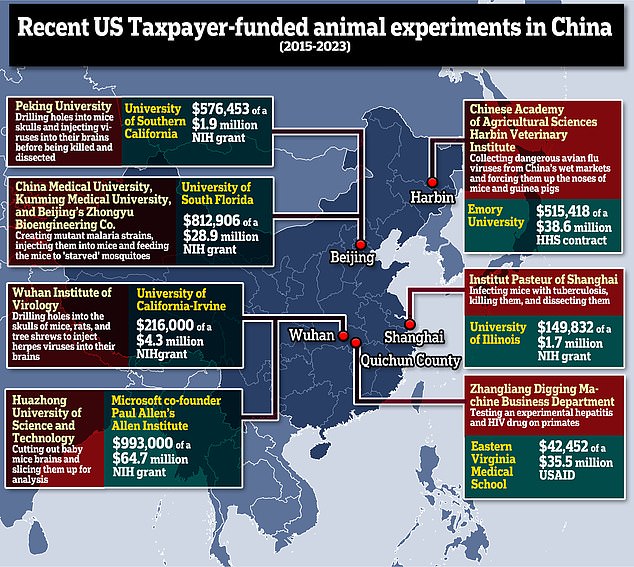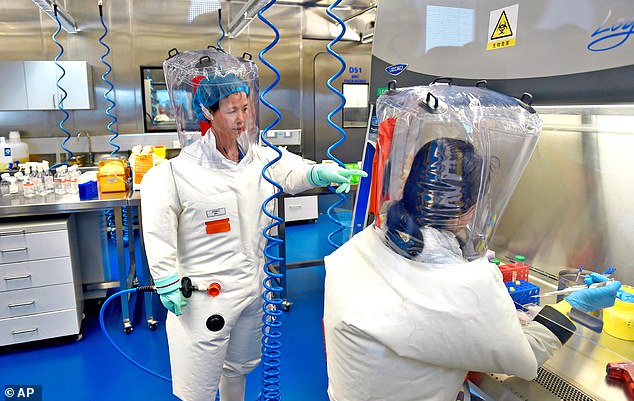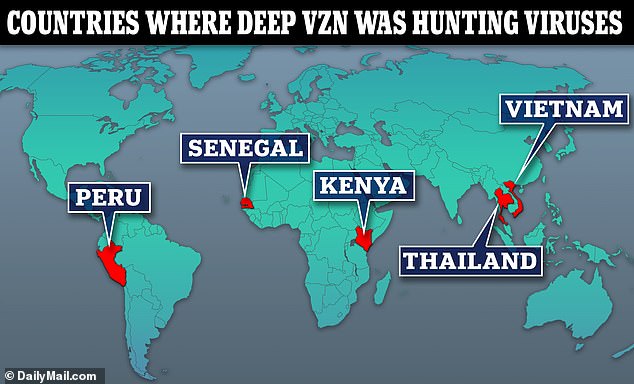Shady research organization linked to Covid lab leak is STILL receiving $25 million in US taxpayer money despite trying to defraud the DoD
EcoHealth Alliance, the controversial organization at the center of the Covid-19 pandemic, continues to receive taxpayer money to study contagious animal-borne viruses in Asia and Africa.
Data from the government's USA Spending database shows that EHA has received at least eight grants from the Department of Defense since 2017, totaling more than $32 million, for projects involving experiments with coronaviruses, Ebola and MERS .
EHA, led by British zoologist Peter Daszak, is a New York-based organization that has funneled taxpayer money from the National Institutes of Health to China's Wuhan Institute of Virology, which is conducting risky gain-of-function research.
In experiments like this, scientists deliberately alter viruses to make them more contagious or deadly – and the WIV is the laboratory where Covid is believed to have been created and leaked from, causing a global epidemic that is estimated to directly or indirectly kill more than 22 million people cost his life. people.
Despite EHA's connection to the WIV and Covid, six of the government grants were initiated after the pandemic spread across the world.
Dr. Peter Daszak (pictured left next to Dr. Anthony Fauci) oversees the EcoHealth Alliance

Between 2015 and 2023, at least seven U.S. entities provided National Institutes of Health grant funding to laboratories in China that conduct animal testing, totaling $3,306,061

Shi Zhengli – dubbed the 'Bat Lady' or 'Bat Woman' for her work on bat coronaviruses – explored the possibility that Covid could have emerged from her lab in 2020, according to colleagues
In addition, documents released this week appear to show that Daszak and several other researchers tried to mislead the Defense Department in 2018 about efforts to conduct risky experiments in Chinese labs with more relaxed security measures than labs in the US.
The experiments would see researchers “engineer spike proteins” to infect human cells that would then be “inserted into the SARS-Covid backbones.”
However, the proposal was not approved for grant money and the research was not conducted with US taxpayer money.
In a statement Tuesday, EHA called the documents “incomplete” and said the “allegations are false, based on a misunderstanding of edits and comments on the document, and based on misleading quotes out of context and a lack of understanding of the process by which federal grants are awarded.
All eight DoD grants were awarded to EHA through the department's Defense Threat Reduction Agency (DARPA), a division of the DoD responsible for developing emerging technologies for use by the military.
One grant awarded before the pandemic ran from October 2017 through October 2023.
It was awarded $6.5 million and a description of the project said its aim was to understand the risk of the emergence of bat-borne zoonotic diseases in Western Asia.
An August 2019 grant, expected to be completed in August 2024, awarded $5 million with the aim of reducing the threat of Rift Valley Fever, a viral hemorrhagic fever most common in domesticated animals in southern Africa the Sahara, including cattle, buffalo, sheep, goats and camels.
The virus has the ability to jump from animals to humans through blood, bodily fluids and bites. Most people experience no symptoms of the virus or may develop a mild illness with fever and dizziness.
Rarer and life-threatening symptoms include excessive bleeding, eye disease, and swelling of the brain.
Five grants awarded after the outbreak of the Covid pandemic, between June 2020 and December 2022, focused on studying high-risk animal-borne pathogens in African and Asian countries that cause fatal febrile and haemorrhagic diseases, such as Ebola virus , Marburg virus, Nipah virus, MERS and coronaviruses and bird flu.
They are expected to run until December 2025.
One grant running from July 2021 to May 2024 aims to predict the impact of biothreats through data and learning, but does not mention working with viruses or animals.
Dangerous research such as that carried out by EHA has scientists and politicians concerned about the possibility that it could cause a new pandemic. Because of these concerns, the U.S. quietly halted a $125 million taxpayer-funded project in September that had researchers hunting for new viruses.
DEEP VZN – pronounced deep vision – was launched in October 2021 with the aim of finding and studying new pathogens in wildlife in Asia, Africa and Latin America.
Although the research was intended to prevent human outbreaks and pandemics, critics, including Biden administration officials, worried it could do the opposite and expressed fear about the potentially “catastrophic risks” of the virus hunt.
The project was supposed to run until 2026, but DEEP VZN was closed in July 2023 without formal public announcement.

USAID's DEEP VZN project (pronounced deep vision) was hunting for viruses among wildlife in Asia, Africa and Latin America.
DEEP VZN, which stands for Discovery & Exploration of Emerging Pathogens – Viral Zoonoses, was launched by the United States Agency for International Development (USAID) in October 2021 and less than two years later, USAID officials briefed members of Senate committees with jurisdiction over DEEP VZN the program was closed.
The premature closure of the project came abruptly and was communicated privately to Senate aides by the office of Atul Gawande, USAID's assistant administrator for global health.
The news was buried in a hundreds of pages of congressional budget document and discussed during interviews with federal lawmakers and investigators.
At the launch, USAID said the “ambitious new project” aimed to work with partner countries and the global community to “build greater preparedness for future global health threats.”
The aim was to collect more than 800,000 samples over the five-year period, mainly from wildlife, to identify a subset of 'previously unknown' viruses that 'pose a significant pandemic threat'.
After the termination, USAID said it would instead focus on improving laboratory capacity, disease monitoring, human resources, biosafety and security, and risk communication.
